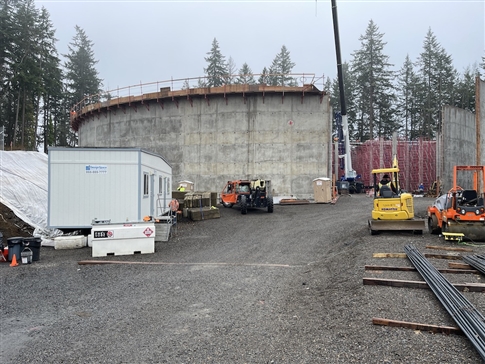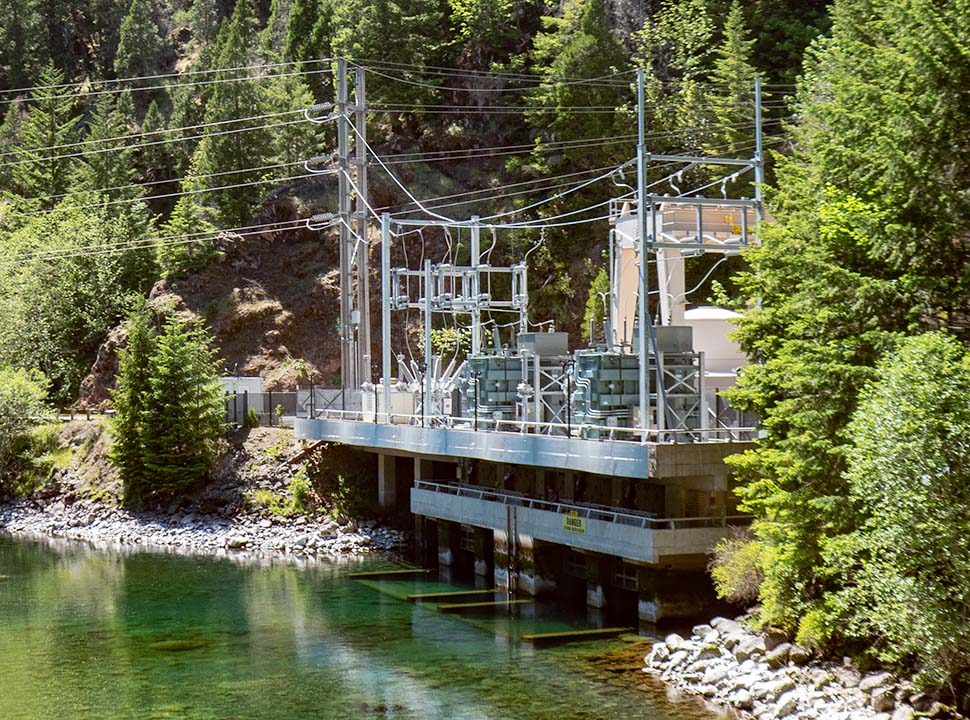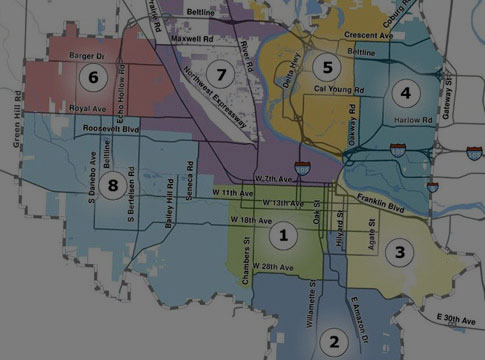As a community-owned utility, we do not operate to earn a profit. Prices are based on the costs to serve our community with safe, reliable water and electricity.
Explore this page: Current residential prices | Current commercial prices | 2025 price changes | Your rate changes over time | Where do your dollars go? | Our committment to affordability | How rates are set | Save money
Recent news
September 2025: The Bonneville Power Administration Rate Change and Your EWEB Bill - Throughout the 2025 budget and rate-setting process, we communicated that a BPA pass-through would occur in October, originally estimated at 4% for residential customers. BPA’s finalized rate increase is smaller than projected, and EWEB’s pass-through adjustment effective October 1, 2025 will now be 2.7% for residential customers.
August 2025: Oregon’s New Utility Laws and How EWEB Customers Already Benefit from Fair, Transparent Rates - Oregon’s POWER Act and FAIR Energy Act target investor-owned utilities. Learn how EWEB’s local, community-owned model already meets these goals.
August 2025: Balancing Reliability and Affordability - The costs of delivering water and electricity are rising. At the same time, we must consider what our community can realistically afford. Check out your monthly bill newsletter to learn how we’re controlling near-term costs while moving forward with strategic investments.
July 2025: Board of Commissioners provides strategic direction for 2026 budget and rates - At the July public meeting, EWEB commissioners confirmed strategic and operational priorities, business and economic forecast assumptions, Capital Improvement Plans, and Long-Term Financial Plans used to guide the 2026 budget and customer rates. Read the public memo and watch the presentation (34 minutes).
2025 prices
In December 2024, after months of public meetings and deliberation, your elected Board of Commissioners approved EWEB's 2025 budget and customer rate adjustments.
- For an average household using 1,600 kilowatt-hours of electricity and 9,000 gallons of water per month, rate increases amount to less than $1 per day.
- This includes an EWEB rate increase effective in February 2025, and a Bonneville Power Administration rate increase effective in October 2025.
The $490 million budget accounts for economy-wide inflation and funds essential projects to enhance the resiliency of Eugene’s electricity and water systems.
Estimate your electricity costs
Download our bill calculator (Excel file) to easily estimate your 2025 energy costs based on your household usage.
Residential price changes
| 2024 | 2025 (Includes Oct. BPA rate increase) |
|
|---|---|---|
| Electric Basic Charge | $25 per month | $30 per month |
| Electric Usage Charges1 | 10.32¢ per kilowatt hour (kWh) | 11.16¢ per kilowatt hour (kWh) |
| Water Basic Charge | $24.09 per month | $25 per month |
| Water Usage Charge2 | $1.80 per thousand gallons (kgals) | $1.98 per thousand gallons (kgals) |
1 Includes (1) Delivery Charge, which covers the costs to operate and maintain the wires, transformers, poles, and other equipment it takes to send power, and (2) Energy Charge, which covers the costs of producing the electricity and sending it long distance to our distribution system.
2 Based on average usage 9,000 gallons per month for single-family house inside city limits; excludes wholesale customers, elevation pumping fees, and temporary $3 watershed recovery charge, which sunsets in 2026.
Non-residential price changes
| SMALL (Up to 30 kW per month) |
MEDIUM (31-500 kW per month) |
LARGE (501-10,000 kW per month) |
|
|---|---|---|---|
| ELECTRIC1 | 6.7% (EWEB) + 2.5% (BPA) | 5.1% (EWEB) + 3.5% (BPA) | 8.6% (EWEB) + 4.1% (BPA) |
| WATER | 8.3% | 8.3% | 8.3% |
1 EWEB price change effective Feb. 2025. BPA price change effective Oct. 2025.
Some of the major factors driving 2025 price changes
- Water investments – including constructing a treatment plant on the Willamette River, replacing aging water storage tanks, and strengthening pipelines
- Electric investments – including rebuilding aging substations, and upgrading the Carmen-Smith hydroelectric project
- Global inflationary pressures – since 2020, inflation has increased significantly, and our rate increases haven't kept up; there has been a gap of about 20% between EWEB price increases and the rate of inflation since 2016
- Regulatory Environment – Increasing regulations are placing more requirements and restrictions on EWEB investments and operations
BPA rate change effective October 2025
Bonneville Power Administration (BPA) is a nonprofit federal agency that provides wholesale energy and transmission services to utilities in the Northwest. EWEB buys almost 80% of Eugene’s electricity from BPA. Every other year, BPA updates its rates, and customer rates are automatically adjusted to reflect these costs.
To ease impacts on customers, 2025 electric rate increase are staggered: an EWEB rate increase in February 2025, followed by a direct passthrough of a Bonneville Power Administration (BPA) rate increase in October 2025.
How have your rates changed over time?
We value and respect our customer-owners’ financial resources by controlling costs and rates.
Electric and water prices remained stable for five years from 2017-2021 as a result of budget trimming, debt restructuring, and careful reprioritizing of select projects. During this time EWEB was able to maintain funding for limited income bill assistance programs, conservation incentives, and infrastructure investments.


Where do your dollars go?
When you pay your bill, you deserve to know where your dollar goes, what may impact future prices and how you can reduce your monthly costs.
As a customer-owned utility, EWEB does not operate to earn a profit. You own EWEB – not independent investors or shareholders.
That means that unlike an investor-owned utility, there are no profit margins or shareholder dividends built into your EWEB rates. Electric and water prices are based on the costs to:
- Operate and maintain the electric and water systems
- Meet regulatory obligations and statutes
- Invest in system improvements that make your services better
- Protect natural resources near our facilities, and
- Maintain the financial health of the utility

What do you get for $1?
As an EWEB customer, the average rate for a kilowatt-hour (kWh) of electricity is about 10 cents. Put another way, you could power an energy-efficient 9-watt LED light bulb for more than 1,000 hours for only a dollar. You could watch around 250 hours of TV or charge an electric bike 15 times. Where else can you get that kind of value?
How much food, coffee or medicine will $1 buy? How far would you get with a dollar of gas?
And what about your smartphone? Using EWEB’s price of about 10 cents per kWh, you can fully charge your iPhone more than 1,800 times for $1. That means you can charge your phone once every day of the year for about 20 cents total.
The cost of water is even less. Using EWEB’s price of about $1.50 per 1,000 gallons you could take 39 showers, run your dishwasher 190 times, water more than 1,000 square feet of lawn—all for less than $1.
| What can you get for $1? | |
|---|---|
| Candy bar | 1,000 hours of light (9-watt LED) |
| Scratch-off lottery ticket | 50 hours of running desktop computer |
| Postage stamp | 250 hours of watching TV (32”) |
| Cup of instant noodles | 1,800 mobile phone charges |
| Less than 1 gallon of bottled water | Almost 1,000 gallons of tap water |
The average EWEB residential customer pays about $7 per day to power their entire home and less than $2 per day for water. Considering how much we depend on clean, reliable power and water 24 hours per day, seven days per week, 365 days per year, that’s a great value.
Your rates support clean energy
Here in the Pacific Northwest, we are fortunate to have access to some of the cleanest power in the nation. About 90 percent of EWEB’s annual energy comes from carbon-free resources and we’re committed to doing even better.In January 2022, the Board of Commissioners approved a Climate Change Policy (PDF) that targets over 95 percent of annual energy from carbon-free resources by 2030. That means that your rates support a grid that’s getting greener over time.
Learn how we're planning for EWEB's long-term energy needs.
Your rates keep the lights on and water flowing
The clean, safe water and electricity we all rely on would not be possible without the infrastructure that delivers it. From power plants to distribution and transmission lines, substations and transformers, pipes, reservoirs and pump stations — utility infrastructure is a complex system that requires investment and maintenance to provide constant, reliable power and water.
EWEB plans for major infrastructure investments through our Capital Improvement Plan, a 10-year plan for rehabilitating, replacing or installing new infrastructure.
To meet the current and future needs of our community and ensure reliable service, some of the major projects we’re planning and budgeting for include:
- Rebuilding substations to increase capacity and improve reliability
- Investing in updated meter technology to reduce costs and improve service
- Implementing wildfire safety and prevention programs
- Building a water treatment plant on the Willamette River to improve the resiliency of our water supply
- Upgrading the Carmen-Smith Hydroelectric Project
- Upgrading and supplementing water storage tanks
- Addressing the structural vulnerabilities of the Leaburg Canal
Basic charges explained
If you look at your EWEB bill, you will notice different types of charges that make up the total amount owed. These types of charges vary by customer class (residential, commercial, and industrial), but fixed charges (Cost of Basic Service) and volumetric charges (kWh and KGAL) are always present. The fixed charge is intended to ensure each customer is paying a fair share of the cost to access electric and water services.
Our Commitment to Affordability
EWEB’s prices for power and water are comparable to or less than state, regional and national averages.
| Energy Information Administration Data | Price per kWh |
|---|---|
| EWEB (2025 rates) | About 13.04 cents |
| Oregon | 15.77 cents |
| Idaho | 12.07 cents |
| Washington | 12.98 cents |
| California | 33.52 cents |
| U.S. | 17.47 cents |
Source: EIA Average Price of Electricty by State June 2025 and 2024
But we understand the economic pressures facing so many customers and we work hard to control costs and operate as efficiently as possible. Our 2025 budget reflects investments to ensure we can continue to provide safe and reliable water and electricity even as critical infrastructure ages and new challenges arise.
Some of the ways we maintain affordability include:
- Using low-cost hydropower to meet the majority (80%) of Eugene's electricity needs
- Using our trading floor to buy and sell electricity on the wholesale market to cost-effectively balance supply and demand
- Carefully planning and analyzing spending on capital projects and operational requirements
- Using debt wisely and minimizing our borrowing costs
- Offering financial support to help customers manage their energy use and invest in energy efficiency improvements that can reduce bills year-round
- Carefully managing inventory and supply chain issues
- Leveraging state and federal funding to supplement programs and offset costs
- Supporting the health and safety of our workforce to keep insurance costs as low as possible
- Spreading the costs for major improvement projects over many years to avoid having to raise rates significantly in any one year
- Continuously improving to drive greater efficiency and lower costs
How Your Rates are Set
The prices you pay are meant to promote efficient use of water and electricity and to ensure that EWEB adequately covers our costs in a way that is fair, stable and affordable to customers.
There are three main activities associated with setting customer rates:
- Determining a revenue requirement: How much does EWEB need to collect from customers in a year to cover costs associated with running the utility?
- Allocating the revenue requirement: How do we ensure various customer classes (residential, business, large industrial, etc.) pay their fair share of the cost for getting water and power to their homes and facilities?
- Establishing rates: How do we set prices that reflect the fixed and variable costs of providing services and incentivize customers to use electricity and water wisely?
EWEB begins the rate-setting process annually every spring.
Through a series of public meetings, your elected Board of Commissioners provides direction on spending for major capital projects and potential price changes for customers.
During the summer and fall, EWEB staff follow that direction from the Board to develop a proposed spending budget for the following year.
The final budget is adopted in December after two public hearings in November and December during which customers are invited to provide testimony on any proposed adjustments.
Read more: How does EWEB recover the costs of serving customers?
Looking to the future
Utility rate setting practices continue to evolve with advancing energy markets and technology.
Looking ahead, we will need to continue to design rate structures that reflect the true costs of providing electric and water services. We’re exploring ways to better align rates with the times of the day when electricity is in highest demand.
Investments in smart meters, coupled with technologies such as electric vehicles and smart home appliances, will change traditional electricity pricing, allowing us to offer more accurate rate structures that provide customers with more choices and control.
One example is real-time pricing. Other utilities have implemented programs where electricity prices vary hourly over the course of the day to reflect fluctuating costs of providing that electricity. When the costs are lower for the utility, the costs are lower for the customer.
Just as prices for electricity can vary hour by hour, so can the carbon content of electricity production.
Although EWEB's energy portfolio is composed almost entirely of carbon-free power, we are part of a highly integrated regional energy grid that includes coal and natural gas. When the highest ("peak") level of electricity is being used in the region, there is generally more of this carbon-intensive energy on the grid. Prices can be set to reward customers for shifting their energy use to off-peak hours and to take advantage of surplus renewables on the grid.
These are just a few of the possible changes on the horizon. But even as we look at price changes in 2025 and beyond, we are interested in keeping rates as low as possible because we know that our customers value affordability and expect that from us.
How you can save money and manage your bill
At EWEB, we have always encouraged efficiency and conservation first. We like to say the cheapest, greenest electron is the one you never use. That’s why we make around $3 million per year available to help customers upgrade things like windows, insulation, water heaters, and heating units. Rebates are enhanced for limited income customers, in some cases covering the full cost to upgrade.
Rebates and zero-interest loans can make your home more energy efficient.
Conserving energy and water can reduce your utility costs.
Bill assistance is available to qualifying customers.
Did you winter electric bill take a jump? This video explains how to read your bill to uncover reasons for the increase.
Related Programs
We're making investments to prepare, replace and maintain our community's water system.









